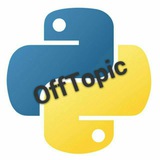
Telegram-канал pythonofftopic - Offtopic
 14069
14069
Offtopic group for casual talking about anything. @rules_for_python still apply (except for the ontopic rule)

 14069
14069
Offtopic group for casual talking about anything. @rules_for_python still apply (except for the ontopic rule)

Legasy means mbr bios.but i think it is gpt.and my bootable USB is uefi based.so this is not a problem
Читать полностью…
Always remember, DMN is not the right or wrong perception, it's only one of the perceptions of reality you can feel. Search about it and you'll see
Читать полностью…
If I don't have the possibility or pay university fees, can I learn data science through self-education?
Читать полностью…
How you ended here whithout beign part of the ontopic groups?
Читать полностью…
telegram offers some payment methods that involve crypto
Читать полностью…
I used Rufus and i have asus motherboard.today i started my pc.and and my windows got hanged.then i restart it.and it was unable to start now because of some missing dlls.then i attach my bootable usb and got this error.but i previously installed windows several time with this same bootable usb.i did some researched on this.and i found that i have to clean my hardisk for proper installation
Читать полностью…
🧠 Psychedelics & the Brain: A Neuroscience Overview
1. Default Mode Network (DMN) – The Brain’s Baseline Narrative
The DMN includes the medial prefrontal cortex (mPFC), posterior cingulate cortex (PCC)/precuneus, angular gyrus, and hippocampus. It’s most active during self-referential thought, mind-wandering, and internal narration
→ Psychedelics disrupt the DMN, correlating with:
• Ego-dissolution
• Decreased rumination
• Emotional openness
• Altered sense of time and self
🔗 PubMed, PubMed, Frontiers
2. Network Rebalancing – Cross-Talk & Functional Connectivity
When DMN activity decreases, connectivity across brain networks increases, especially between:
• Salience Network (SN)
• Task-Positive Network (TPN)
This shift enhances:
• Sensory awareness
• Emotional salience
• Inter-network fluidity
→ Under psilocybin, DMN-TPN cross-connectivity increases—blurring boundaries between introspection and external attention.
🔗 PubMed
3. Thalamus – The Gatekeeper of Perception
The thalamus filters and relays sensory information to the cortex. Psychedelics disrupt this filter:
• LSD increases thalamocortical connectivity, especially with sensory & DMN regions → Sensory overload and blending
• Psilocybin alters thalamic connections with visual and self-related networks
→ More “raw” information floods through—less filtered by habitual cognitive hierarchies.
🔗 Wikipedia, AJNR, Frontiers
4. DMT & Neuroplasticity
DMT acts strongly at 5‑HT₂A receptors, disrupting DMN activity and boosting global brain connectivity.
Animal and cell studies show DMT also promotes:
• Dendritic growth
• New synapse formation (synaptogenesis)
• Anti-inflammatory gene expression
→ Suggests potential for long-term neural rewiring and healing.
🔗 Vox, MDPI
5. Thalamocortical Resonance & Consciousness
The thalamocortical oscillation hypothesis suggests synchronized rhythms between thalamus and cortex help bind together our unified sensory experience.
→ Psychedelics disrupt this resonance, potentially uncoupling perception from language-driven meaning and allowing more direct, unstructured experiences.
🔗 Wikipedia
🎯 Conceptual Integration
• The DMN = your internal “you-narrative” (memory, language, culture)
• The thalamus = filters sensory input → constructs "reality"
• Psychedelics turn down the DMN + loosen thalamic filters → more bottom-up data floods the system
• What breaks through is “the It”—an unsymbolized, raw experience outside of typical conceptual frameworks

Please, don't take me wrong, i just wanna spread knowledge
Читать полностью…
Thalamus will reduce the actual objective reality, so we are never really in touch with it... Our brain is just used to DMN
Читать полностью…
Stay safe in home, away from traffic while doing dmt. 👍
Читать полностью…
I saw the preview before joining, seems I cant chit chat there so found the pinned message and came here
Читать полностью…
Yes this is exactly to learn and deepen continuously this is beauty
Читать полностью…